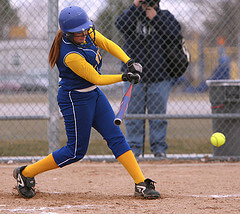When one of our hitters get two strikes, as coaches we immediately think that the hitter needs to do something different mechanically in order to put the ball in play. Have you ever heard a coach/parent tell Suzi Slugger to “Choke Up” whenever she gets two strikes? Is sounds so easy. The question I always asked myself as a hitter and now as a coach, is why make the change mechanically when you rarely get to practice it? For those coaches who make the time to practice hitting with two strikes, I take my hat off to you.

Maybe not changing technique or philosophy when the hitter has two strikes is more productive. But maybe not! Assuming the batter has good bat control, she’s relaxed, maintains confidence and focus and has a disciplined strike zone, maybe her approach to hitting with two strikes should not change. Without repetition, any mechanical change will be uncomfortable at first. The hitter may be uncomfortable when she has a two strike count. The game plan has to be accepted by the hitter. This is actually the first technique in adjusting to a two strike count. As a coach I am comfortable allowing the hitter to make no physical adjustment, especially if we don’t have the practice time to work on individual philosophy.
However, if the hitter frequently has a poor at-bat when faced with a two strike count, other alternatives should be considered. Other techniques that any hitter in this situation might adopt include:
1) Choking up
2) Splitting the grip
3) Taking no stride
4) Inside/out swing
5) reduce the zone.
The reasons for changing technique are to help the batter increase bat control, maintain confidence and be quicker to impact. This may also allow the hitter to wait longer. Without a game plan it is more difficult to improve skills. Assuming we have the time, let’s consider each of the two-strike alternatives mentioned above.
Let’s start with choking-up. This is simply asking the hitter to make an adjustment by moving the grip up further on the handle. By doing this, bat control should be improved. But be aware that balance and comfort may be affected. All other factors of hitting are the same.
Secondly, the split-grip also theoretically increases bat control. Ask yourself whether bat speed is reduced when using either of the above techniques? Adjust the top hand so there is approximately three to four inches between the hands.
Employing a no stride technique may actually allow the bat to reach the impact area quicker. Removing the stride may increase the time a hitter has to make a decision about the pitch.
Adopting and inside/out type swing may allow the batter to wait on the pitch longer. This allows the hitter to be more selective. You may want to work on adjusting the batter’s hands during the swing to outside or inside pitches. Lining up the belly button and back heel depending on location is another change to “squish the bug.” Actually, this may be helpful in all of these two strike adjustments.
Using the zone type of hitting also employs a philosophy as well as a technique. I feel that a hitter with two strikes is better off reducing the strike zone rather than increasing it. Sure, sometimes the hitter loses. Each hitter is asked to carve out the low outside strike. How well do we hit that one anyway? At best, coach/player expectation would be a foul ball. Because the hitter is also asked to look for a strike from the middle to outside, we know that the inside pitch will cause problems. Can the pitcher locate inside? Therefore, work on hand adjustment is critical. Equally important is staying mentally tough by not giving up psychologically when the ball is contacted down on the handle. Hitting through the ball and finishing properly are important techniques to work on.
As a coach, our team objective for each hitter is to get on base. Base on balls is good! Naturally, the batting order will include different abilities at each spot in the lineup. Even with two strikes the hitter must remain aggressive. A batter who is aggressive will still be thinking hit prior to pitch release (unless take is on), but would check her swing if the pitch is not in her zone. Rather than striking out, we want our hitters to put the ball in play. Preferably, on the ground or over the outfielders head. As coaches, you know that the O.B.A. (On Base Average) and the B.A. (Batting Average) is dramatically reduced when the batter is faced with two strikes. Hopefully, by adding some of the techniques mentioned above your team’s two-strike production will improve.